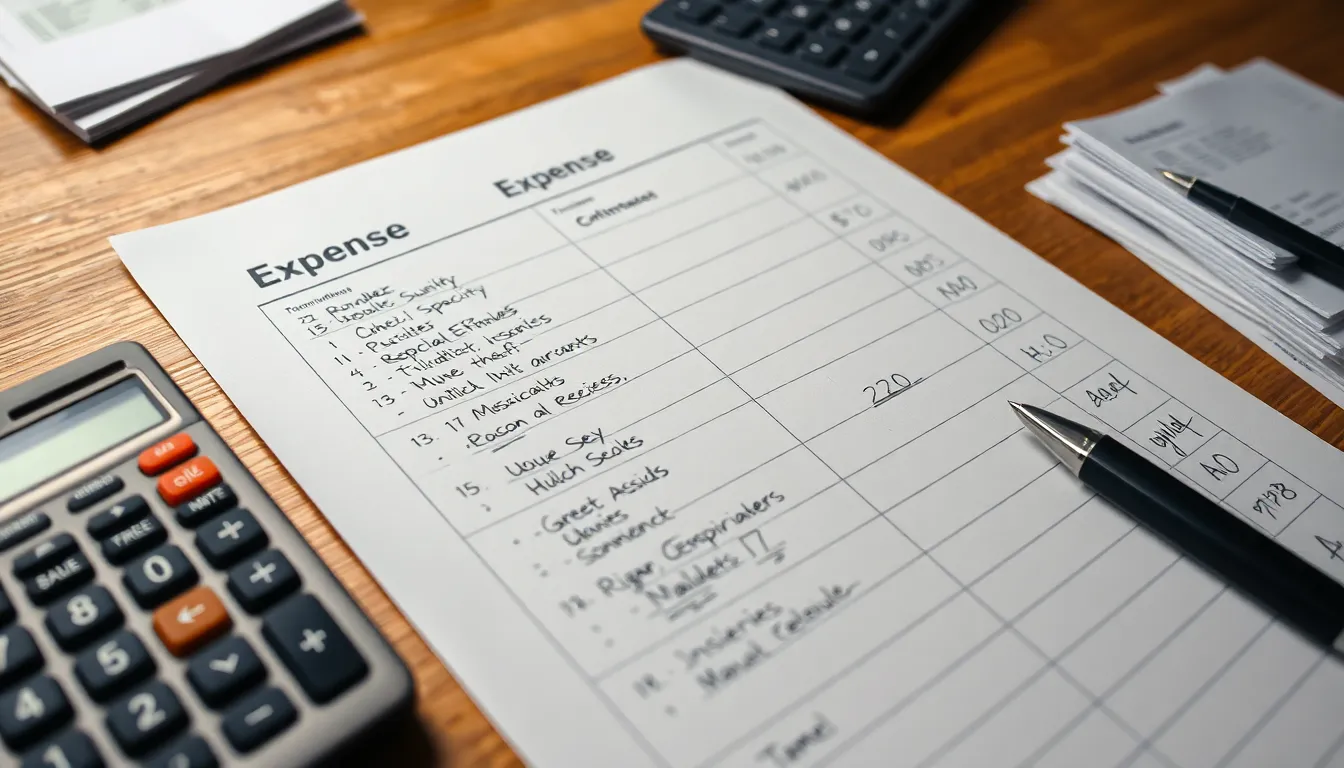Managing finances effectively is crucial for both individuals and businesses. An expense sheet serves as a powerful tool for tracking spending, identifying patterns, and ensuring budget adherence. By organizing financial data in one place, it simplifies the process of monitoring expenses and aids in making informed decisions.
Whether someone is preparing for tax season or looking to cut unnecessary costs, an expense sheet provides clarity and control. With the right format and structure, it can transform chaotic financial information into actionable insights. Understanding how to create and utilize an expense sheet can lead to better financial health and long-term stability.
Table of Contents
ToggleOverview of Expense Sheets
Expense sheets serve as essential tools for tracking and managing financial data. They enable individuals and businesses to systematically record expenditures, categorize spending, and monitor budget adherence. An effective expense sheet typically includes columns for date, description, category, amount, and payment method, offering a clear overview of where money is allocated.
Organizing financial data through expense sheets simplifies the tracking process. Users can view spending trends, identify areas for cost reduction, and make informed decisions about future expenditures. Regular updates to the expense sheet enhance its value, offering real-time insights into financial status.
Particularly during tax season, expense sheets become crucial. They provide the necessary information for tax returns, ensuring individuals and businesses can substantiate their deductible expenses. This capability supports careful tax planning and reduces the chances of errors during filing.
Additionally, expense sheets contribute to improved financial health. By maintaining an up-to-date record of expenses, individuals and businesses gain control over their finances. They can establish budgets based on actual spending and engage in proactive financial planning, leading to long-term stability.
Key Components of an Expense Sheet

Expense sheets comprise essential information that streamlines financial tracking and analysis. Their structured layout supports effective budgeting and decision-making.
Categories of Expenses
Categories of expenses classify spending into distinct segments, enhancing organization and clarity. Common categories include:
- Operational Costs: Expenses related to daily business operations, such as rent and utilities.
- Marketing and Advertising: Investments in promotional activities and materials.
- Travel Expenses: Costs associated with business travel, including transportation and accommodations.
- Employee Benefits: Payments for health insurance, retirement plans, and other employee-related expenses.
- Supplies and Inventory: Costs for materials and goods essential for production or service delivery.
Each category provides insights into spending patterns, enabling better financial management and identification of potential savings.
Tracking Dates and Receipts
Tracking dates and receipts adds accuracy and accountability to expense tracking. Important elements include:
- Date of Transaction: Capturing the exact date helps establish a timeline for expenses.
- Receipt Collection: Keeping physical or digital copies of receipts ensures evidence for each expense, aiding in tax reporting and audits.
- Due Dates: Documenting payment due dates prevents late fees and maintains good relationships with vendors.
- Payment Methods: Noting whether expenses were paid by credit card, cash, or other means provides a complete financial picture.
These practices enhance the reliability of the expense sheet, making it easier to review and analyze financial data.
Benefits of Using an Expense Sheet
Expense sheets offer several advantages that enhance financial management for individuals and businesses.
- Improved Budgeting: Expense sheets facilitate accurate budgeting by providing a detailed view of past spending. Actual expenditure data supports the creation of realistic budgets, making it easier to allocate resources effectively.
- Enhanced Financial Awareness: Tracking expenses creates awareness of spending habits. Individuals and businesses can identify unnecessary or excessive expenses, enabling adjustments that lead to better financial habits and control.
- Real-Time Insights: Regular updates to an expense sheet provide real-time insights into spending patterns. This immediacy allows for timely financial adjustments, ensuring alignment with financial goals.
- Simplified Tax Preparation: Organizing expenses simplifies the tax preparation process. Expense sheets compile necessary tax information in an accessible format, reducing errors and improving accuracy during filing.
- Accountability: Maintaining an expense sheet promotes accountability. Documenting expenditures encourages responsible spending and can prevent financial overspending or mismanagement.
- Identification of Cost-Saving Opportunities: By analyzing categorized expenses, individuals and businesses can uncover potential savings. Understanding spending trends highlights areas where cost reductions are feasible.
- Financial Forecasting: Expense sheets aid in forecasting future spending based on historical data. This forecasting supports informed decision-making about investments and resource allocations.
- Easier Financial Reporting: For businesses, expense sheets streamline financial reporting. Compiled data assists in preparing financial statements and presentations, enabling clear communication of financial health.
Implementing an expense sheet enhances overall financial management capabilities, leading to improved decision-making and financial success.
How to Create an Effective Expense Sheet
Creating an effective expense sheet requires careful planning and the right tools. These elements assure accurate tracking and management of finances.
Choosing the Right Format
Choosing the right format for an expense sheet ensures clarity and usability. Common formats include:
- Spreadsheet Software: Applications like Microsoft Excel or Google Sheets allow customization and formulas for automatic calculations.
- Template Options: Pre-designed templates found online can save time. They often include necessary columns and categories.
- Mobile Applications: Expense tracking apps provide on-the-go functionality and sync with bank accounts for real-time updates.
Each format has its strengths, so selecting one aligns with personal or organizational needs and preferences.
Essential Tools and Software
Essential tools enhance the effectiveness of an expense sheet. Consider utilizing:
- Spreadsheet Programs: As mentioned, Excel and Google Sheets provide versatile features for budget tracking.
- Expense Management Software: Services such as Expensify or Mint streamline data entry and analysis with user-friendly interfaces.
- Cloud Storage: Tools like Google Drive or Dropbox allow secure storage and easy access to documents from various devices.
Using these resources simplifies expense documentation and supports comprehensive financial oversight.
Tips for Maintaining Accurate Records
- Update Regularly: Updating the expense sheet frequently ensures that data reflects current spending. Aim for daily or weekly updates to capture all transactions promptly.
- Organize Categories: Organizing expenses into clear categories, such as operational costs or travel expenses, simplifies tracking and analysis. Use consistent naming conventions for easy reference.
- Attach Receipts: Attaching digital or physical copies of receipts provides proof of transactions. Store receipts in an organized manner, either in a folder or a cloud storage system, along with the expense sheet.
- Document Dates: Recording transaction dates accurately prevents confusion during financial reviews. It helps track spending patterns and aligns with budgeting timelines.
- Note Payment Methods: Including details about payment methods enhances accountability. It provides insights into cash flow and helps identify which methods incur additional fees.
- Review Monthly: Reviewing the expense sheet monthly helps identify trends and potential savings. It allows for timely adjustments to budgets and spending habits.
- Utilize Software Tools: Using expense management software enhances accuracy and efficiency. Choose tools that automate data entry and generate reports, saving time and reducing errors.
- Train Team Members: Training individuals responsible for expense tracking ensures everyone understands the process. Consistency among team members improves data integrity and reduces discrepancies.
- Perform Annual Audits: Conducting annual audits of the expense sheet verifies accuracy and helps identify areas for improvement. It reinforces accountability and highlights trends that need further attention.
An expense sheet serves as an essential component of effective financial management. By providing a clear overview of spending habits it empowers individuals and businesses to make informed decisions. Regular updates and organized categories enhance its effectiveness allowing for real-time insights that can lead to significant cost savings.
Utilizing the right tools and software can further streamline the tracking process making it easier to maintain accurate records. With the right approach an expense sheet not only simplifies budgeting but also supports long-term financial stability. Embracing this practice can transform financial oversight into a proactive strategy for success.




